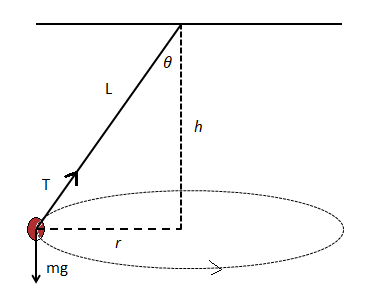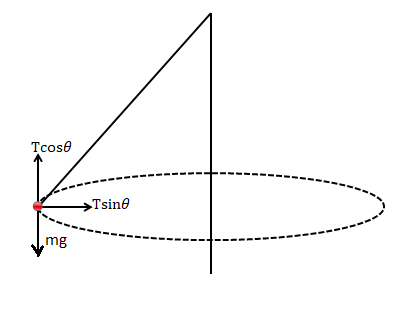
In a conical pendulum, the axial height of a right circular cone described by the string is $\sqrt 3$ times the radius of the circular path of its bob. The tension in the string is:
A) \[2{\text{ }}mg\]
B) $\sqrt {3mg} $
C) $\dfrac{2}{{\sqrt 3 }}mg$
D) $\dfrac{1}{{\sqrt 3 }}mg$
Answer
218.4k+ views
Hint: A conical pendulum is a string with a mass attached at the end. The mass moves in a horizontal circular path and forms a right circular cone.A right circular cone is a cone where it’s axis is the line meeting the vertex to the midpoint of the radius of the circle. The center point of the base of the circle is joined with the apex of the cone and it forms a right angle.

Formula used:
\[T\cos \theta = mg\]
Here, $T$ = tension created in the string
$r$ =radius of the circular path
$h$ = Axial height of the right circular cone
$l$ = height of the right circular cone that is slightly slant.
$mg$ = weight of the bob
$\theta $= $h$ and the string angle in between them measured in degrees
Complete step by step answer:
Let us consider the given tension diagram.

Here we divide the tension $T$ into two components that is a vertical and a horizontal.
The horizontal component is \[ = Tsin\theta \]
The vertical component \[ = Tcos\theta \].
So, according to the diagram,
\[T\cos \theta = mg\], where \[\cos \theta = \dfrac{h}{L}\]
Given, \[h = \sqrt 3 r\]
\[\therefore L = \sqrt {{r^2} + {{(\sqrt 3 r)}^2}} \] this can also be written as:
\[ \Rightarrow L = \sqrt {{r^2} + 3{r^2}} \]
Or,
\[ \Rightarrow L = \sqrt {4{r^2}} \]
Or,
\[ \Rightarrow L = 2r\]
So from,
\[T\cos \theta = mg\]
\[ \Rightarrow T = \dfrac{{mg}}{{\cos \theta }}\]
\[ \Rightarrow T = \dfrac{{mg}}{{\dfrac{h}{l}}}\]
\[ \Rightarrow T = \dfrac{{mgl}}{h}\]
\[ \Rightarrow T = mg \times \dfrac{{2r}}{{\sqrt 3 r}}\]
\[\therefore T = \dfrac{2}{{\sqrt 3 }}mg\]
Therefore the tension of the string \[T = \dfrac{2}{{\sqrt 3 }}mg\].
Hence the answer is the option (C).
Note: When two or more objects that are in contact, they exert force on each other and this particular force is called a Tension. Tension is the force that acts along a medium of the rope especially where the force is carried. Since the tension does not cause any displacement, the work done in the tension is zero and it acts in the opposite direction of the gravity force.

Formula used:
\[T\cos \theta = mg\]
Here, $T$ = tension created in the string
$r$ =radius of the circular path
$h$ = Axial height of the right circular cone
$l$ = height of the right circular cone that is slightly slant.
$mg$ = weight of the bob
$\theta $= $h$ and the string angle in between them measured in degrees
Complete step by step answer:
Let us consider the given tension diagram.

Here we divide the tension $T$ into two components that is a vertical and a horizontal.
The horizontal component is \[ = Tsin\theta \]
The vertical component \[ = Tcos\theta \].
So, according to the diagram,
\[T\cos \theta = mg\], where \[\cos \theta = \dfrac{h}{L}\]
Given, \[h = \sqrt 3 r\]
\[\therefore L = \sqrt {{r^2} + {{(\sqrt 3 r)}^2}} \] this can also be written as:
\[ \Rightarrow L = \sqrt {{r^2} + 3{r^2}} \]
Or,
\[ \Rightarrow L = \sqrt {4{r^2}} \]
Or,
\[ \Rightarrow L = 2r\]
So from,
\[T\cos \theta = mg\]
\[ \Rightarrow T = \dfrac{{mg}}{{\cos \theta }}\]
\[ \Rightarrow T = \dfrac{{mg}}{{\dfrac{h}{l}}}\]
\[ \Rightarrow T = \dfrac{{mgl}}{h}\]
\[ \Rightarrow T = mg \times \dfrac{{2r}}{{\sqrt 3 r}}\]
\[\therefore T = \dfrac{2}{{\sqrt 3 }}mg\]
Therefore the tension of the string \[T = \dfrac{2}{{\sqrt 3 }}mg\].
Hence the answer is the option (C).
Note: When two or more objects that are in contact, they exert force on each other and this particular force is called a Tension. Tension is the force that acts along a medium of the rope especially where the force is carried. Since the tension does not cause any displacement, the work done in the tension is zero and it acts in the opposite direction of the gravity force.
Recently Updated Pages
Two discs which are rotating about their respective class 11 physics JEE_Main

A ladder rests against a frictionless vertical wall class 11 physics JEE_Main

Two simple pendulums of lengths 1 m and 16 m respectively class 11 physics JEE_Main

The slopes of isothermal and adiabatic curves are related class 11 physics JEE_Main

A trolly falling freely on an inclined plane as shown class 11 physics JEE_Main

The masses M1 and M2M2 M1 are released from rest Using class 11 physics JEE_Main

Trending doubts
Understanding Collisions: Types and Examples for Students

Understanding Atomic Structure for Beginners

Understanding Centrifugal Force in Physics

Understanding Electromagnetic Waves and Their Importance

What Are Elastic Collisions in One Dimension?

Understanding Excess Pressure Inside a Liquid Drop

Other Pages
NCERT Solutions For Class 11 Physics Chapter 4 Laws Of Motion

NCERT Solutions for Class 11 Physics Chapter 3 Motion In A Plane 2025-26

NCERT Solutions For Class 11 Physics Chapter 12 Kinetic Theory - 2025-26

NCERT Solutions For Class 11 Physics Chapter 13 Oscillations - 2025-26

Motion In A Plane Class 11 Physics Chapter 3 CBSE Notes - 2025-26

Understanding Elastic Collisions in Two Dimensions




